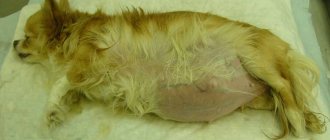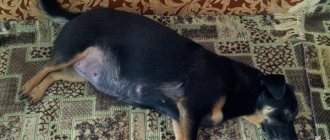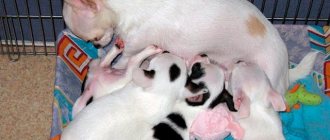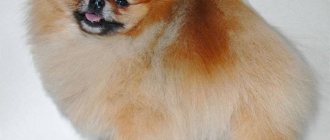Pregnancy in a dog lasts 60-62 days. However, viable offspring can be born at 58 days and up to 72 days. The gestation period varies depending on the breed of the animal. In large dogs and “pocket” dogs it can differ significantly.
Usually dogs give birth easily and humans do not need to interfere with the process. Difficulties can arise during the first birth and in very small dogs. In this case, you need to have the veterinarian’s phone number so that you can contact him if something goes wrong.
The birth of puppies for your pet is a great joy and, at the same time, responsibility. It is important to recognize the onset of labor.
How long does labor last in dogs?
Normal labor lasts from 3 to 12 hours. 15-20 minutes after the birth of the first cub, the placenta comes out and the next puppy is born. In multiple pregnancies, the intervals lengthen to two hours.
If the process of expulsion of fruits continues from 12 to 24 hours, whelping is considered complicated. Pathological childbirth lasts longer than a day.
Preparing for childbirth
Pregnancy lasts two months. You need to prepare for childbirth in advance: decide on a place for a den, select the necessary tools and materials for obstetrics and receiving newborns.
What you will need
You need to prepare the following items:
- oilcloth, clean sheets that you don’t mind throwing away;
- baby box;
- scales;
- sterilized scissors;
- suture material;
- alcohol, brilliant green;
- thermometer;
- syringes;
- Vaseline or baby cream;
- antiseptic ointment;
- solutions of ascorbic acid, glucose 5%, calcium gluconate 10% for injection.
- warmer;
- trash bin.
You should have a veterinarian’s contact number, a notepad and a pen on hand to record data on the live weight of newborns, the order and circumstances of their birth.
Place for birth
They select a box or playpen into which the bitch is placed when she begins to nest. Choose a place where no one will disturb the pet. Clean bedding and favorite toys are placed in the den, which are removed when signs of childbirth appear.
At home or in a clinic?
The following indications are available for whelping at home:
- In most cases, bitches whelp without problems. They do not require the help of a veterinarian or even an owner.
- Minimize stress during transportation to and from the clinic. The expectant mother gets used to the den.
- The veterinarian examined the pet before giving birth, recommended whelping at home, left a contact phone number, and promised to come to the house if the need for his services arises.
- There are no additional costs required to keep an animal in the clinic.
The dog owner needs to master the skills of cutting, tying and cauterizing the umbilical cord, cleaning babies from mucus and amniotic sac.
Whelping is carried out in the clinic when the following indications exist:
- Breed predisposition to pathological childbirth.
- Previous births were difficult and ended in caesarean section.
- The birth of stillborn or weakened cubs in a previous pregnancy.
- The use of medications to preserve pregnancy.
The dog owner must make a decision on his own: where to give birth to his dog - at home or in a clinic. During surgery, a sterile room, equipment, instruments, and a team of veterinarians will be required.
How to understand that childbirth is near
A week before whelping, the belly drops; if you examine the bitch from above, it seems that she has lost weight. Hair falls out around the nipples. The dog begins to nest - fuss, look for a place for a den.
3-5 days before whelping, whitish mucus is released from the vulva. 2 days before the event, the bitch begins to constantly lick the genitals. The udder enlarges, the nipples swell, and sometimes colostrum is released from them. In the middle of the ninth week of gestation, thermometry should be carried out. A drop in temperature below 37°C for large bitches and 36°C for small bitches occurs 12 hours before whelping.
How to understand that your pet is pregnant?
In the early stages it is impossible to say anything. Sometimes the bitch becomes quieter, more peaceful, eats a lot or a little. You can notice something only in the second month of gestation:
- The belly is getting bigger.
- Weight increases.
- The mammary glands protrude and slightly change color at the nipples.
- There is something like a mucous discharge coming from the genitals.
- Gently feeling the stomach, you feel hard lumps.
The extreme and already “finishing” factor is that the dog tries in every possible way to arrange its home for the puppies. You will notice it immediately and will not confuse it with anything. It is better to go to the veterinarian in the second month and get an x-ray to know how many babies to expect.
Childbirth process by stages
The following stages of normal childbirth are distinguished:
- Contractions are contractions of the muscles of the uterus.
- Attempts to contract the muscles of the abdominal wall. The water breaks and the puppy is born.
- Expulsion of the placenta.
Contractions last from 2 to 24 hours. The second and third stages of whelping occur and end many times, depending on the number of cubs. During a normal birth, 15-30 minutes after the placenta leaves, the next baby is born. After the appearance of 4-5 cubs, there is a break and the next series of puppies comes out.
The bitch herself frees the baby from the shell, gnaws the umbilical cord, licks the newborn, who immediately finds the nipple. The owners help the pet: free the baby from the placenta, cut the umbilical cord, bandage it, burn the stump with alcohol or brilliant green.
First moments of newborn puppies
Puppies are born at intervals of 15-30 minutes.
When delivering a baby, you need to take notes on:
- Weight and moment of birth of puppies;
- Appearance sequences;
- Field;
- Color;
- Other appearance features.
Each puppy is licked by a bitch after birth. They find their way to the nipples, but not all babies succeed, so we need to help them. Application to the nipples speeds up labor and helps the uterus contract better.
Another positive side of the quick application is that colostrum, entering the baby’s body, stimulates intestinal function.
How to deliver a dog at home
When intense contractions begin, the bitch should lie down on her side. Sometimes animals give birth standing up. Shortly before labor begins, the amniotic sac bursts and the water breaks.
There is no need to help your pet with this by trying to pierce the bubble.
From the moment the birth canal is washed with water, contractions become as intense as possible.
No more than three hours pass before the first puppy appears. If this time drags on, call veterinary help immediately! Complications may arise that could cause you to lose both mother and offspring.
At birth, pushing becomes prolonged and very painful. The abdominal muscles and diaphragm actively contract. Babies come out with both their muzzle forward and their hind legs - this is normal. Your task is to help the pet by accepting newborns.
Each baby is born in its own amniotic sac. Usually the bitch chews it herself. If she does not do this, break the bubble yourself and free the newborn as quickly as possible so that he can breathe. If he does not move, is covered in blood or greenish mucus, clean his mouth and nose as quickly as possible, and clear his airways of fluid.
Your help will also be useful in cutting the umbilical cord. If for some reason the bitch does not do it herself, help her. Gently push the blood in the umbilical cord towards the baby. With one hand, pinch the umbilical cord 3 cm from his tummy, with the other - 2-3 cm from the first hand.
Cut off the umbilical cord with the hand closest to the newborn, holding the other motionless and firmly. It’s better to just cut it off - there’s practically no blood this way. If you still had to cut it with scissors or if blood came out when it was cut, tie it with silk thread, previously disinfected.
Cut the umbilical cord quickly, do not allow the dog or the puppy to pull on it - this can cause an umbilical hernia.
After every birth, the placenta comes out. Often she is pushed out by the next one behind the newborn. You have to wait the longest for the latest one to come out. Record the number of afterbirths released - it should coincide with the number of births. At the slightest suspicion that one of them has not left the birth canal, be sure to show the dog to the veterinarian. A failed placenta can lead to serious inflammation of the uterus.
Childbirth and the delivery of the placenta is a messy process and fertile ground for the development of infections. Keep it clean, try to change the bedding after each puppy comes out.
After cleaning the amniotic sac from the baby and cutting the umbilical cord, hand it over to the mother. She will lick the newborn, nudge him, stimulating breathing and blood circulation. Try to get newborns to the nipples as quickly as possible. Sucking will help the uterus contract more intensely.
After the first sips of colostrum, puppies expel blackish meconium, the original feces. This starts the digestive processes. If the baby is weak and cannot cope on his own, help him by lightly massaging his stomach and anus with a damp cotton swab.
Try to protect the bitch and newborns from anxiety. Keep them in a room where people do not often go, keep strangers away. Provide your pet with peace and safety.
Discharge, diarrhea
During the first two weeks after birth, dogs experience mucous discharge with bloody impurities. Gradually they become colorless. If the owner discovers that the pet has a lot of bloody or dark green discharge, be sure to show the new mother to the veterinarian. The former can be provoked by uterine bleeding, and the latter by an inflammatory process occurring in the abdominal cavity.
Diarrhea is considered normal after childbirth. It is observed during the first two to three days and goes away on its own. To speed up this process, dairy products should be excluded. Bone meal will help strengthen the stool, but giving bones is not recommended.
Increased body temperature, heavy breathing, lack of appetite, exhausted appearance, weakness are alarming symptoms. Their combination is a good reason to immediately contact a veterinarian.
Features of childbirth in different breeds and sizes
Dogs of large, small, short-faced breeds are prone to pathological whelping. Great Danes, Labradors, Bullmastiffs, Pugs, Bulldogs, Toy Terriers, and Yorkies are at risk.
The dog owner should consult with a veterinarian or dog handler and find out whether the animal is at risk for birth complications.
You might be interested
Otodectosis or ear mites in dogs and how to deal with it
Pet illnesses are usually easy to treat if they can be diagnosed early. But even without…read more
Cancer in dogs
A cancerous tumor is a frightening diagnosis not only for humans, but also for a four-legged pet. By …read more
Pyoderma in dogs: how to recognize the disease
Pyoderma in dogs is a disease that affects the skin of a dog, the causative agent of which is staphylococcus bacteria. In …read more
Trichotyphia in dogs or "ringworm"
Trichotyphia in dogs is a fungal infection of the skin and hair of dogs, better known as ...read more
Abdominal hydrocele or ascites, we diagnose it ourselves
Ascites or abdominal dropsy is a dangerous pathology that can be fatal for your pet. Let's consider…read more
Inducing labor in a dog
The need to stimulate whelping arises in the following cases:
- pregnancy lasts 10 weeks or more;
- 24 hours have passed since the onset of labor, but the puppies have still appeared;
- 2 hours have passed since the puppy was born, and the new cub has not yet appeared.
There are medicinal and bodily stimulation.
Medication
A dog breeder can use the following medications without harm to the pet’s health:
- Ascorbic acid, 5%, intramuscularly from 2 to 3 ml.
- Glucose 5% subcutaneously, 5 ml/kg.
- Calcium gluconate, 10% - 5 ml/10 kg of weight, intramuscularly.
Other medications are prescribed by your veterinarian.
Corporeal
Massage is carried out after providing medical assistance.
Stimulation consists of the following manipulations:
- massage the belly from head to tail;
- lubricate fingers with cream or Vaseline, rub the perineum in a circular motion;
- express colostrum, stroke nipples;
- massage the vaginal walls with clean fingers with trimmed nails, covered with antiseptic ointment.
Vaginal massage is combined with stroking the abdomen. If after three minutes the expected result does not occur, the manipulation is repeated after a quarter of an hour. If induction of labor does not work, seek veterinary help.
When you can't do without a veterinarian
Veterinary assistance will be required in the following situations:
- A foul-smelling discharge from the vulva appeared.
- Labor continues for more than 12 hours.
- Contractions last more than 150 minutes, but labor does not occur.
- 3 hours have passed since the last puppy came out, but the contractions continue.
- Bleeding occurred.
- The babies are still born.
- Convulsions began.
Before whelping, you need to agree with a veterinarian who will agree to provide assistance at home.
Possible complications
During childbirth, dogs experience the following complications:
- weakened labor;
- non-elastic vaginal walls;
- “dry” birth;
- a dead, abnormally walking or large puppy;
- retained placenta;
- the puppy got stuck;
- narrow pelvis
Weak labor
After prolonged pushing, contractions stop and labor stops. They carry out medical and physical stimulation of labor or remove the offspring by caesarean section.
The vaginal walls are not elastic
Complications arise during the first whelping. After the first baby appears, the vaginal walls become elastic. But the problem is that the bitch cannot give birth to her first child.
The owner should invite a veterinarian who will inject petroleum jelly into the vagina and
Dry birth
When the water breaks before the baby is born, the fetus becomes stuck in the birth canal and its advancement causes pain. The problem is solved by introducing Vaseline oil into the vagina.
Dead, large or abnormally walking puppy
When a dog pushes for 2 or 3 hours and the baby does not appear, it means it is coming out incorrectly, too large or dead. In all cases, you need to call a veterinarian. In such cases, a caesarean section is indicated.
Retained placenta
After childbirth, it is necessary to count the number of placenta: it should be equal to the number of newborns. The last placenta usually comes out on its own.
If this does not happen or the separation of the placenta remains unnoticed, massage the abdomen and inject 1 or 2 ml of oxytocin subcutaneously. Sometimes the bitch eats the child's place. You can't give more than two. It is necessary to take into account the afterbirth eaten.
Puppy stuck
When a baby is stuck in the birth canal, an intramuscular injection of the antispasmodic No-Shpa solves the problem. Veterinarians adapted the drug for the treatment of dogs. Smooth muscles relax 3-5 minutes after administration of 1-2 ml of the drug.
Narrow pelvis
A congenital anomaly or a juvenile developmental defect makes childbirth impossible. The life of the mother and the offspring is saved by a caesarean section. Before breeding a bitch, her reproductive abilities should be assessed.
Animal care, feeding
Let's assume that the dog's birth was successful. This process takes a lot of energy from the mother, so she needs rest and peace. It is important that the pet is in a dry and warm place, and that the owner has the opportunity to look after it. The presence of strangers is not allowed. A new mother may worry that someone might encroach on her babies.
During the first 6-8 hours after birth, the animal needs only clean water. Then you can start feeding the dog. Preference is given to light and soft food, 5-6 meals a day are encouraged. It is important that the new mother’s diet does not contain high-calorie foods. This can lead to an overabundance of milk and inflammation of the mammary glands.
Postpartum recommendations and dog nutrition
Mothers with offspring provide peace. A lactating female needs 3 times more calories than a single female. At the same time, they take into account that the pet cannot eat a lot of low-calorie food: the stomach puts pressure on the uterus, which has not yet recovered from childbirth and hurts. Therefore, the diet should contain energy-rich, easily digestible foods. The need for minerals and vitamins increases. The veterinarian will advise what fertilizer to use and in what quantity.
Responsible dog breeders switch a pregnant bitch to ready-made puppy food of at least super premium class. Pellets should be in the feeder at all times. Ready-made food increases milk production and reduces weight loss. The puppies watch their mother, visit her feeder, and easily switch from liquid milk to solid milk.











